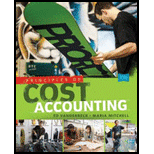
Concept explainers
Materials and labor variances
Fausto Fabricators Inc. uses a

The following operating data came from the records for the month:
In process, beginning inventory, none.
In process, ending inventory, 800 units, 80% complete as to labor; material is issued at the beginning of processing.
Completed during the month, 5,600 units.
Materials issued to production were 51,680 lb @ $.55 per pound. Direct labor was $384,000 for 40,000 hours worked.
Required:
Calculate the following variances, using the diagram format in Figure 8-4.
- 1. Materials price.
- 2. Materials quantity.
- 3. Net materials variance.
- 4. Labor rate.
- 5. Labor efficiency.
- 6. Net labor variance.
(Hint: Before determining the standard quantity for materials and labor, you must first compute the equivalent units of production for materials and labor.)
Trending nowThis is a popular solution!

Chapter 8 Solutions
Principles of Cost Accounting
Additional Business Textbook Solutions
Accounting Information Systems (14th Edition)
Principles of Microeconomics (MindTap Course List)
Corporate Finance (4th Edition) (Pearson Series in Finance) - Standalone book
Foundations Of Finance
Intermediate Accounting (2nd Edition)
Horngren's Accounting (12th Edition)
- I am searching for the correct answer to this general accounting problem with proper accounting rules.arrow_forwardPlease explain the solution to this general accounting problem with accurate explanations.arrow_forwardI am searching for the accurate solution to this general accounting problem with the right approach.arrow_forward
- Please provide the accurate answer to this general accounting problem using appropriate methods.arrow_forwardI need help solving this general accounting question with the proper methodology.arrow_forwardI need guidance with this general accounting problem using the right accounting principles.arrow_forward
 Principles of Cost AccountingAccountingISBN:9781305087408Author:Edward J. Vanderbeck, Maria R. MitchellPublisher:Cengage Learning
Principles of Cost AccountingAccountingISBN:9781305087408Author:Edward J. Vanderbeck, Maria R. MitchellPublisher:Cengage Learning Managerial AccountingAccountingISBN:9781337912020Author:Carl Warren, Ph.d. Cma William B. TaylerPublisher:South-Western College Pub
Managerial AccountingAccountingISBN:9781337912020Author:Carl Warren, Ph.d. Cma William B. TaylerPublisher:South-Western College Pub Financial And Managerial AccountingAccountingISBN:9781337902663Author:WARREN, Carl S.Publisher:Cengage Learning,
Financial And Managerial AccountingAccountingISBN:9781337902663Author:WARREN, Carl S.Publisher:Cengage Learning, Cornerstones of Cost Management (Cornerstones Ser...AccountingISBN:9781305970663Author:Don R. Hansen, Maryanne M. MowenPublisher:Cengage LearningPrinciples of Accounting Volume 2AccountingISBN:9781947172609Author:OpenStaxPublisher:OpenStax College
Cornerstones of Cost Management (Cornerstones Ser...AccountingISBN:9781305970663Author:Don R. Hansen, Maryanne M. MowenPublisher:Cengage LearningPrinciples of Accounting Volume 2AccountingISBN:9781947172609Author:OpenStaxPublisher:OpenStax College Managerial Accounting: The Cornerstone of Busines...AccountingISBN:9781337115773Author:Maryanne M. Mowen, Don R. Hansen, Dan L. HeitgerPublisher:Cengage Learning
Managerial Accounting: The Cornerstone of Busines...AccountingISBN:9781337115773Author:Maryanne M. Mowen, Don R. Hansen, Dan L. HeitgerPublisher:Cengage Learning





